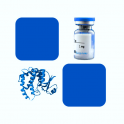
- Remove this product from my favorite's list.
- Add this product to my list of favorites.
Products
Viewed products
Newsletter
 |  |  |  |  |  |

Background
Sclerostin (SOST) also known as Sclerosteosis, VBCH, is a secreted glycoprotein with a signal peptide for secretion and a C-terminal cysteine knot-like (CTCK) domain and belongs to the Cerberus/DAN family of bone morphogenetic protein (BMP) antagonists. Sclerostin is produced by the osteocyte and has anti-anabolic effects on bone formation. More recently Sclerostin has been identified as binding to LRP5/6 receptors and inhibiting the Wnt signalling pathway. Wnt pathway inhibition under these circumstances is antagonistic to bone formation (meaning Sclerostin antagonizes bone formation). It has been shown that SOST binds BMP-5, -6, and -7 with high affinity and BMP-2 and -4 with low affinity. Sclerostin production by osteocytes is inhibited by parathyroid hormone, mechanical loading and cytokines including oncostatin M, cardiotrophin-1 and leukemia inhibitory factor. Sclerostin production is increased by calcitonin. Thus, osteoblast activity is self regulated by a negative feedback system. Mutations of Sclerostin is associated with the syndrome Sclerosteosis, and reduced sclerostin expression results in a milder form of the disorder called van Buchem disease.
Source
Recombinant Biotinylated Human SOST, His Tag, primary amine labeling(SOT-H8245) is expressed from human 293 cells (HEK293). It contains AA Gln 24 - Tyr 213 (Accession # AAI01087.1).
Predicted N-terminus: His
Molecular Characterization
This protein carries a polyhistidine tag at the N-terminus.
The protein has a calculated MW of 22.3 kDa. The protein migrates as 25-35 kDa under reducing (R) condition (SDS-PAGE) due to different glycosylation.
Biotinylation
The primary amines in the side chains of lysine residues and the N-terminus of the protein are conjugated with biotins using standard chemical labeling method. A standard biotin reagent (13.5 angstroms) is used in this product.
Biotin:Protein Ratio
Passed as determined by the HABA assay / binding ELISA.
Endotoxin
Less than 1.0 EU per μg by the LAL method.
Purity
>95% as determined by SDS-PAGE.
Formulation
Lyophilized from 0.22 μm filtered solution in PBS, pH7.4 with trehalose as protectant.
Reconstitution
Please see Certificate of Analysis for specific instructions. For best performance, we strongly recommend you to follow the reconstitution protocol provided in the COA.
Storage
For long term storage, the product should be stored at lyophilized state at -20°C or lower.
Please avoid repeated freeze-thaw cycles.
-20°C to -70°C for 12 months in lyophilized state;
-70°C for 3 months under sterile conditions after reconstitution.
Bioactivity
Please refer to product data sheet.
(1) "Alternated activation with relaxation of periosteum stimulates bone modeling and remodeling"
Saulacic, Katagiri, Fujioka-Kobayashi et al
Sci Rep (2024) 14 (1), 11136
(2) "Analysis of factors influencing vascular calcification in peritoneal dialysis patients and their impact on long-term prognosis"
Cao, Shi, Liu et al
BMC Nephrol (2024) 25 (1), 157
(3) "Sclerostin blockade inhibits bone resorption through PDGF receptor signaling in osteoblast lineage cells"
Thouverey, Apostolides, Brun et al
JCI Insight (2024) 9 (10)
Showing 1-3 of 1889 papers.
Follow us